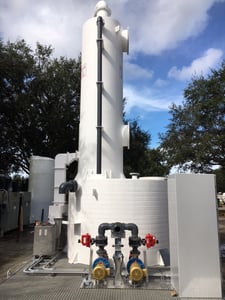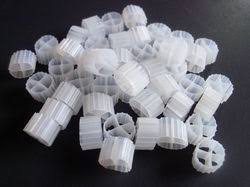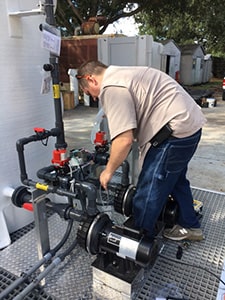Basics of water decarbonation for dissolved organic carbon.
The water treatment industry continues to develop and evolve. Over the past two decades, there have been many new developments in technology and even more refinement in existing technologies such as "Degasification ". The evolution and advancement of water treatment have been driven by the constantly increasing demand from an increase in population that demand cost-effective solutions and recognition to improve safety with the implementation of NSF 61 standards.
". The evolution and advancement of water treatment have been driven by the constantly increasing demand from an increase in population that demand cost-effective solutions and recognition to improve safety with the implementation of NSF 61 standards.
All human cultures on our planet share a single commonality: the dependency on water to survive.
Many existing technologies, such as "Degasification," have evolved with higher efficiency to meet the demand changes and provide safety to consumers and the systems. Degasification refers to the removal of dissolved gases from liquids, and the science to degasify water is based upon a chemistry equation known as "Henry's Law". The "proportionality factor" is called Henry's law constant" and was developed by William Henry in the early 19th century. Henry's Law states that "the amount of dissolved gas is proportional to its partial pressure in the gas." The most "cost" effective method to perform degasification is with the packed vertical tower called a "Degasifier” or “Decarbonator.”
The key words in this previous sentence for owners, operators, and engineers to focus on is "the most cost-effective" as there is no other process more cost-effective at removing dissolved gases at the lowest cost than using a Degasifier or decarbonator. The process of degasification is simple enough to understand. Water is pumped to the top of a vertically constructed tower, where it first enters the tower through some type of distribution system at the same time, there is a cross-current air flowing up from the bottom by a blower located at the bottom of the tower, and the air encounters the water and is exhausted at the top of the tower through an exhaust port. There are various types of distribution systems, and we will explore these in later discussions. Once the water enters the top of the tower and passes through the distribution system, it then travels by gravity downward. The next thing the water encounters is some type of media packing. There are various forms of media packing offered in the degasification industry, and each type can offer higher performance or have the ability to deter fouling. The selection of the type, size, and volume is where the “experience, engineering, and understanding of each application” comes into play.
 Once the water encounters the top of the media, it begins its journey downward by gravity
Once the water encounters the top of the media, it begins its journey downward by gravity
Quickly equilibrates and depending on the volume of water to the size of the tower it establishes its “Hydraulic Load” within the media bed. The hydraulic load is calculated during the design phase and plays a key role in the selection of the size of the tower and even the type of media to be utilized. Each application requires careful consideration to provide the highest efficiency and lowest operating cost. Depending on what type of media is utilized within the vertical packed column the degasification process begins as the water travels downward and the media bed constantly reshapes the water droplets over and over again. The spreading and reshaping of the water allow new trapped gas molecules to travel to the surface edge of the water and expose the gas molecules to the countercurrent air flow. As the water with the dissolved gas molecules travel downward and encounters the cross-current air flow the gas molecules are “stripped” from the water at a rate that is dependent on the proportional pressure. There are several “Henry’s Laws” formulas that can be utilized to calculate the degasification process such as (H xp= X/P) and (Hcc= Hcp X RT) just to identify a couple that plays a role during the engineering and design phases of selecting and sizing a degasification and decarbonation tower. All of the stripped gases are entrained in the air stream and then leave the tower through the exhaust at the top of the tower. This is the “basics of water degasification”.
Why utilize degasification in a water treatment process?
There are many reasons that degasification and decarbonation are utilized, and some are related to the treatment of drinking water and others to boiler-feed water treatment.
However, there are forms of degasification that are required during the manufacturing and production of chemicals, medicines, and even cosmetics. But the most prevalent need is water. Quite often, when water is utilized in the production of steam, it must first undergo a rigorous treatment process consisting of removing all salts and other harmful elements that will damage and degrade the boiler system. The water is often treated with CATION and ANION resins to remove minerals and "soften" the water. During this process, pH is often adjusted, and the formation of CO2 (Carbon Dioxide) is produced or may already be present. The CO2 must be removed through degasification prior to the CATION and ANION bed treatments to avoid higher operating costs and an increase in regeneration cycles.
 There is no other method more cost-effective to remove CO2 than “Degasification for the production of steam.
There is no other method more cost-effective to remove CO2 than “Degasification for the production of steam.
Gases such as CO2 (carbon dioxide) must be removed before the water enters the boiler to prevent corrosion and scaling inside the boiler and its tubes. When CO2 is left in the water, it forms “Carbonic Acid” and begins to corrode all metal surfaces it comes into contact with, reducing the performance and shortening the equipment's life span to produce the steam. In the drinking water industry, C02 is also removed from the water process, but normally this is done to avoid scaling and raise the water's pH. During the production of drinking water, the pH is often lowered to facilitate the removal of the sulfides from the water and to lessen the chances of scaling if the process involves "Reverse Osmosis," "Nanofiltration," "Ultrafiltration," or even water softening. After the water's pH is lowered and filtered through a reverse osmosis treatment, the pH normally needs to be adjusted and raised back to a neutral level of 7. The most cost-effective method is to utilize the degasification process, which is commonly called “Decarbonation”. The CO2 is removed, and the pH rises without injecting other chemicals like sodium hydroxide (Caustic). When water is being treated for the municipal market, very often, other elements like sulfides degasified to remove CO2 and other dissolved gases such as Hydrogen Sulfide (H2S) or, as commonly referred to, consumers, “Rotten egg gas.”
“Degasification” and “Decarbonation” are the most cost-effective technologies.
It removes and performs degasification in a water process. Regardless if you are removing CO2 to elevate the pH of the water by stripping out the carbon dioxide gases or if the removal of manganese and hydrogen sulfide is required. Degasification is the most cost-effective technology to accomplish this task. Many applications require mixed bed water treatment post reverse osmosis treatment, and the removal of CO2 is required before the mixed bed process to avoid placing an additional load on the ANION resin bed. The most prevalent method in the industry is to utilize a forced draft “Decarbonator." Liquid cell membrane technology is another technology available. Still, while it does allow for the removal of certain gases, it also includes a higher operating capital and operating costs than a forced draft decarbonation system. When the pH of the water is first lowered before reverse osmosis to help prevent membrane scaling, it passes through the membrane treatment, and the pH will remain in the acidic range, typically around 5.5-6. After the RO process, the water is pumped into a “Decarbonation” or Degasification system. The CO2 is stripped within the decarbonator and is captured in the catch tank below the tower.
It is common for the pH of the water to increase from 1 to 1.5 units after decarbonation, and the water will have a neutral pH of 7-7.5. This eliminates the additional pH treatment that would otherwise be necessary. If degasification were not utilized to lower the pH, more chemicals would be needed, such as caustic (a base), to raise the pH to a neutral level of 7. The cost of degasification with a degasification tower is far more cost-effective than chemical use when you review the operating cost of a typical water treatment facility. DeLoach Industries Inc. is a 60-year-old company that specializes in the design and manufacturing of; “Decarbonation,” “Degasification,” “Pressure Filtration,” and “Odor Control Systems.” DeLoach Industries has continued to advance the technology of degasification and decarbonation with its vertically packed tower systems. They continually improve efficiency within their systems while lowering operating costs.
D eLoach Industries focuses on key components such as their proprietary "NSF" distribution systems, which begin the removal process and has increased their efficiency 7-8% over conventional distribution systems. The types of media utilized and the ability to properly and evenly distribute the air as it enters the tower. Which has lead DeLoach Industries in the development of the “air vane flow system” and is now a key component that impacts the performance of a degasification tower. DeLoach Industries is currently designing one of the first “smart” degasification tower utilizing “AI” (Artificial Intelligence) on the market which began being released in 2018 to better serve the water professional industry. For more information or to learn more, contact the professionals at DeLoach Industries Inc. at www.DeLoachIndustries.com (941) 371-4995.
eLoach Industries focuses on key components such as their proprietary "NSF" distribution systems, which begin the removal process and has increased their efficiency 7-8% over conventional distribution systems. The types of media utilized and the ability to properly and evenly distribute the air as it enters the tower. Which has lead DeLoach Industries in the development of the “air vane flow system” and is now a key component that impacts the performance of a degasification tower. DeLoach Industries is currently designing one of the first “smart” degasification tower utilizing “AI” (Artificial Intelligence) on the market which began being released in 2018 to better serve the water professional industry. For more information or to learn more, contact the professionals at DeLoach Industries Inc. at www.DeLoachIndustries.com (941) 371-4995.




